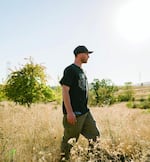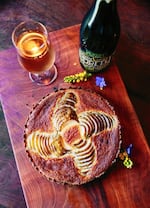If you chop down apple trees in Oregon's Willamette Valley, will pear trees mysteriously grow in their place?
During the second half of the 20th century, settlers in the lower valley planted orchards full of cider-purposed apple varietals grafted onto hardy pear rootstock.

Sean Kelly roams among wild pear and apple trees on the Eugene-Goshen border in Lane County, public land where he picks fruit for commercial cidermaking.
Copyright Isaac Lane Koval
By the 1980s, many of those heritage orchards were being abandoned, tree trunks bulldozed, roots torn out. But pear suckers shot up from tenacious taproots. Animals like deer and raccoons ate the new wild pears and distributed their seeds.
In an unexpected twist, over this last decade the comeback pear has turned into one of the most invasive tree species in the valley, according to Sean Kelly, founder/owner of WildCraft Cider Works in Eugene. His company makes bottled and on-tap wild dry ciders — fermented, alcoholic juice — using whole fruits, most from within a 30-mile radius.
This is Kelly's third year picking feral fruit from remnants of Lane County homestead farms to make his unsulfated, unfiltered, unpasteurized Pioneer Perry. His recipe for Perry-Poached Pear Frangipane is included in the recently published guide "Tasting Cider" by Erin James and CIDERCRAFT magazine.
These lower valley lands include "hundreds of properties, dozens of unspoken-for orchards, smaller lots of trees," he said. About 80 percent is in private hands and access is "relationship-specific, grassroots — we network with people."
Related: Pass The Cider Sampling Platter, Please
The cidermaker collaborates with nonprofit conservation groups and others on what he describes as an "old-orchard restoration project, a full-scale community effort to help manage resources, create access and beautify the landscape. The main objective is to ensure land stewardship."
WildCraft also works with cities and the county to harvest on their lands, which are often sprayed to keep burgeoning wild fruit at bay. "I look at the aerial spray maps to make sure we are not within 4 miles," said Kelly.
Although this season Kelly's crew handpicked from trees on 230 properties (up from 175 last year), conditions were wet during April's pollination, reducing bottling volume by two-thirds, so he has had to buy other fruit.
Bartlett is a common rootstock, and Kelly describes his pear cider as a blend of Bartletts and wild seedlings "that show no varietal distinction. Pears recede but are not true to variety," so they can't be identified. The perry is pressed through long-cut straw and matures in tanks before bottling. Carbonation comes from yeast in the pears.
Pioneer has a "honeylike profile, orange blossom, a bit of citrus — a richer flavor" than many apple-cider cousins, Kelly said. "A bit more viscosity. A nuttiness, like walnuts without tannins." And slipping through its 6.5 to 9 percent alcohol content, a sweet note from unfermentable sugars.
On Oct. 21, at its Eugene tasting room, WildCraft will hold a Gather for the Good Harvest Party, also a celebration of the Community Apple Drive whose participants can barter their own "rescued resources" (extra harvested fruit) for cider through November.

Sean Kelly crafted this Perry-Poached Pear Frangipane as an ode to the classic French dessert. His idea of the perfect accompaniment: A cup of coffee.
Copyright Trask Bedortha
Perry-Poached Pear Frangipane
Bosc pears are best but Red Anjous (before peak ripeness) or Seckels could work in this dessert, said Sean Kelly. Avoid Comice, Kelly said, noting the goal is to use pears that are "small and firm, so they don’t fall apart in the poach." Making and getting the frangipane to the table is a bit of a dance, with various heating and cooling stages, so Kelly suggested poaching the pears before starting the crust. Note that the finished dish is chilled before serving. For Pioneer Perry retail availability, check the cidery website's map but likely sources are neighborhood and artisanal markets and Whole Foods.
Prep: 45 minutes (plus baking) | Average though crust requires quite a bit of hand-work
1 (11-inch) tart
Ingredients
Crust
- 6 tablespoons European-style unsalted butter*
- 1 tablespoon vegetable oil
- 3 tablespoons evaporated cane sugar
- 1/8 teaspoon salt
- 1 cup all-purpose flour
*For its richer taste (sold in blocks)
Pears
- 2 small, firm pears, like Bosc, sliced lengthwise into halves
- 1 (750 ml) bottle WildCraft Pioneer Perry*
- 1/2 cup evaporated cane sugar
*Since this recipe was published in the book, the cidery switched to 500 ml bottles. Kelly encourages using two full bottles for the poaching liquid, but you could pour in half of a second bottle to total 750 ml and sip what’s left.
Filling
- 1/2 cup evaporated cane sugar
- 1/2 cup (1 stick) unsalted butter
- 1 egg
- 1/2 teaspoon almond extract
- 1-1/2 ounces brandy
- 1 cup almond flour or finely ground blanched almonds
- 1 tablespoon all-purpose flour
Garnish
- Mascarpone or whipped cream
To prepare
- Preheat the oven to 410 degrees F (210 degrees C). Lightly butter an 11-inch tart pan with a removable bottom.
- Prepare the crust: Combine the butter, oil, sugar and salt in a glass baking pan and bake for about 4 minutes, keeping a close eye until the mixture browns around the edges. Remove from the oven and briskly whisk in the flour. The mixture will resemble large cookie crumbs, not a dough ball or clump. Transfer the dough to the tart pan, reserving about 2 teaspoons to fill in the cracks that form during baking.
- Once the dough is cool enough to handle, form the rim of the crust by pressing the crust together firmly and working around the pan and then through the center. This is a very crumbly mixture, so pressing together to form a continuous crust is important. With a fork, make a few punctures in the bottom to allow heat to escape. Bake for 10 to 15 minutes, until browned, checking every 2 minutes to see if cracks form. Fill in any cracks with the reserved dough. Once browned, cool the crust in the freezer.
- Meanwhile, prepare the pears: Gently core the pears with a spoon. Combine the perry and sugar in a stainless steel pot and bring to a simmer. Place the pears in the liquid, covering them with parchment paper. Poach for roughly 10 minutes, checking the firmness with a fork. Poaching time will vary depending on the ripeness and variety of pear.
- Remove the pears with 1/4 cup of the poaching liquid and cool in the fridge before handling. Continue to reduce the remaining poaching liquid, covered with parchment paper, at a low simmer for about 15 minutes or until the final liquid is equal to roughly 2/3 cup. Transfer into a dispensing container for easy use (like a squeeze bottle) to cool completely.
- Prepare the filling: In the bowl of an electric mixer, combine the sugar, butter, egg, almond extract and brandy until smooth. Add the almond flour and all-purpose flour, and blend to a paste.
- To assemble, remove the cooled pears and crust from the fridge. Using a spoon or spatula, spread the filling evenly across the crust. Thinly slice the pears into cross-sections and arrange the slices splayed from the center out, with the skin facing up. The filling will rise up around them as it bakes.
- Bake for 15 to 20 minutes, until the surface is completely browned. Remove from the oven, brush with the reserved cooled poaching liquid, and continue baking for another 5 to 10 minutes. When done, cool slightly and let set in the fridge for 3 to 4 hours before removing from the tart pan. The crust is very flaky and can crumble if not handled gently. Slice with a sharp knife, top with a dollop of mascarpone and serve.
From “Tasting Cider, the CIDERCRAFT Guide to the Distinctive Flavors of North American Hard Cider,” copyright 2017 by Sip Publishing. Frangipane photo copyright by Trask Bedortha. Sean Kelly photo copyright by Isaac Lane Koval. Excerpted with permission from Storey Publishing.